Measuring the hallmarks of ageing – how can you track the underlying causes of ageing?
What consumer tests are available to check your hallmarks of ageing and how they're impacting your body?
Join the club for FREE to access the whole archive and other member benefits.
NMN (full name nicotinamide mononucleotide) is a precursor to NAD – a key molecule in cellular energy production. Recently, the awareness of NMN has increased dramatically, particularly due to the public admission by Harvard professor David Sinclair that it is part of his daily supplement regime. His reports of his own, and his father’s, positive experience with it certainly got me interested.
I’ve recently turned 50, so am definitely starting to feel the aches and pains of ageing, even though I do my best to keep in shape and (less successfully) eat and drink healthily. NMN therefore looks like an ideal candidate to try to see whether it makes a meaningful impact on my day to day living.
My plan is to try 1,000 mg (or 1 g) of NMN daily for one month, and track using a health app how I feel and see if there is any improvement in physical or mental health over that period. To provide more objective results, I’m also going to perform a before and after blood test with my regular provider, Medichecks*. See “trial protocol” below for more details.
| This blog is sponsored by DoNotAge. They have generously provided a
month’s supply of Pure NMN capsules. They did not request, and have not
been given, any editorial input to this article. The Live Forever Club
will always provide independent and unbiased information about life
extension. DoNotAge is also offering 10% off all of its products (including quercetin and resveratrol) to Live Forever Club members – view the code on the discounts page. You can see their range of NMN and resveratrol supplements in their online shop: https://www.donotage.org/shop |
Issues covered in this blog post:
NMN works at a very low level in the body’s metabolism. It’s doesn’t do anything exciting itself, like creating antibodies or fibres, it just recycles another molecule when it gets used up. That doesn’t sound very exciting, but when the molecule it is recycling is NAD, its importance becomes more apparent.
NAD (nicotinamide adenine dinucleotide) switches between its two forms, NAD+ and NADH, by accepting electrons (for example from food) and donating them to other processes. This supports many other crucial reactions in the cell that enable energy production and cellular signalling.
NAD+ helps to produce ATP via glycolysis, the citric acid cycle and the electron transport chain (inside mitochondria). Most cells in the body use approximately one billion ATP molecules every minute – so if there isn’t enough NAD around to replenish the ATP your cells start to die. That’s why NMN as a NAD booster, which increases energy metabolism, could be one of the most effective supplements available.
NAD also plays an important role in cellular signalling. One of the most critical is the maintenance of sirtuins which are involved in coordinating an array of crucial functions such as blood vessel growth, stem cell rejuvenation and DNA repair.
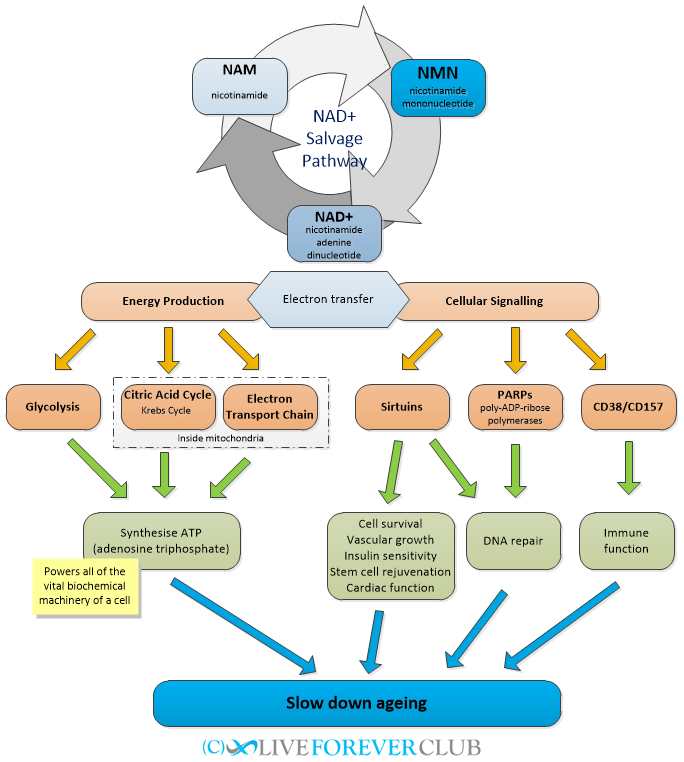
NAD levels reduce with age2,3,5 resulting in mitochondrial dysfunction, glucose intolerance and cellular senescence to name just a few. Back in 2012, researchers at University of New South Wales4 examined the NAD content of skin tissue in humans of different ages. The results showed a pretty clear decline in NAD levels the older we get.
-PLOS-ONE.png)
NAD reduction with age (males)
Looking at their best fit curve, I’d estimate the following levels measured in nanograms per milligram of protein (a nanogram is a millionth of a milligram):
| Age | NAD+ (ng/mg) |
|---|---|
| 20 | 3.5 |
| 40 | 2.0 |
| 60 | 1.2 |
| 80 | 0.7 |
I’m 50 – so my cells have about half the amount of NMN in them than when I was 20 – no wonder I only have half the energy!
This means that boosting the level of NAD with NMN has the potential to reverse some of this age-related decline1. So why not take NAD supplements instead of NMN (its precursor)? Two reasons. Firstly, even though there are plenty of articles out there explaining which foods are good sources of NAD, it doesn’t really matter as NAD in food is not able to get into your cells from the gut. Secondly, the NAD that is created in your body is constantly recycled. Unlike some vitamins that can’t be made by the body so have to be ingested every day, most NAD+ is refreshed in the NAD salvage pathway and it is the components of that (e.g. NMN) that need to be consumed to make it work efficiently.
However, nicotinamide mononucleotide is not only a long name, it is also a large molecule. That makes it difficult to get into cells and so it sometimes changes to a smaller molecule, nicotinamide riboside (NR) to allow it to enter a cell, where it chemically transforms back to NMN. Recent research has shown that this isn’t necessary for all cells (e.g. the small intestine of mice) and that most of the increase in NAD+ (for both NR and NMN) comes via the increase in nicotinamide (NAM) that increases the recycling of NAD+.
If NMN sometimes transforms into NR first, is NR is taking nicotinamide riboside an alternative? David Sinclair reports (in Lifespan) that he finds NMN more stable and observed some benefits in mice using it that weren’t seen with NR. I’ll probably do another blog later to discuss the differences as these aren’t the only options – Dave Asprey says (in Super Human) that he takes NAD+ intravenously, though that’s at the extreme end of treatments.
UPDATE: I've now done a trial with NR too - NR Supplements Personal Case Study
Researchers at the Washington University School of Medicine6 looked into how much NMN is in common foods and reported the values below. I’ve added the third column to show how much of each food you’d have to eat to consume the same amount as I’m taking as a supplement. Even for the highest concentration food, soybeans, you’d need to take in over 50 kg per day – so I think it’s fair to say that that’s not a realistic alternative to supplements.
| Food | mg/100 g-Food | kg of food to obtain 1 mg NMN |
|---|---|---|
| edamame | 0.47–1.88 | 53.2 |
| avocado | 0.36–1.60 | 62.5 |
| broccoli | 0.25–1.12 | 89.3 |
| mushroom | 0.0–1.01 | 99.0 |
| cabbage | 0.0–0.90 | 111.1 |
| cucumber | 0.56-0.65 | 153.8 |
| tomato | 0.26–0.30 | 333.3 |
| beef (raw) | 0.06–0.42 | 238.1 |
| shrimp | 0.22 | 454.5 |
I was hoping to include a section on who is taking what, which would also help advise me on the best dosage. Unfortunately, apart from David Sinclair, very few people are public on what they are taking – let alone making any recommendations. Likewise, I’m sharing my experience of the latest anti-ageing supplement to help inform your personal choice – no recommendations, just information. There’s a disclaimer at the bottom of every page, but sometimes it’s worth repeating.
Dr. Sinclair takes 1 g at breakfast every day. I’ve decided to split that dose between morning (with breakfast) and evening (with dinner), so my regimen is 500 mg twice a day12. Some people have reported NMN keeping them awake if they take it in the evening, so I’ll consider moving the second dose forward if necessary.
Also, just to be safe, I’ll be ramping up the dosage, taking 500 mg (at breakfast) for the first 2 weeks, followed by 3 weeks at full 1,000 mg dose. Total trial duration = 5 weeks.
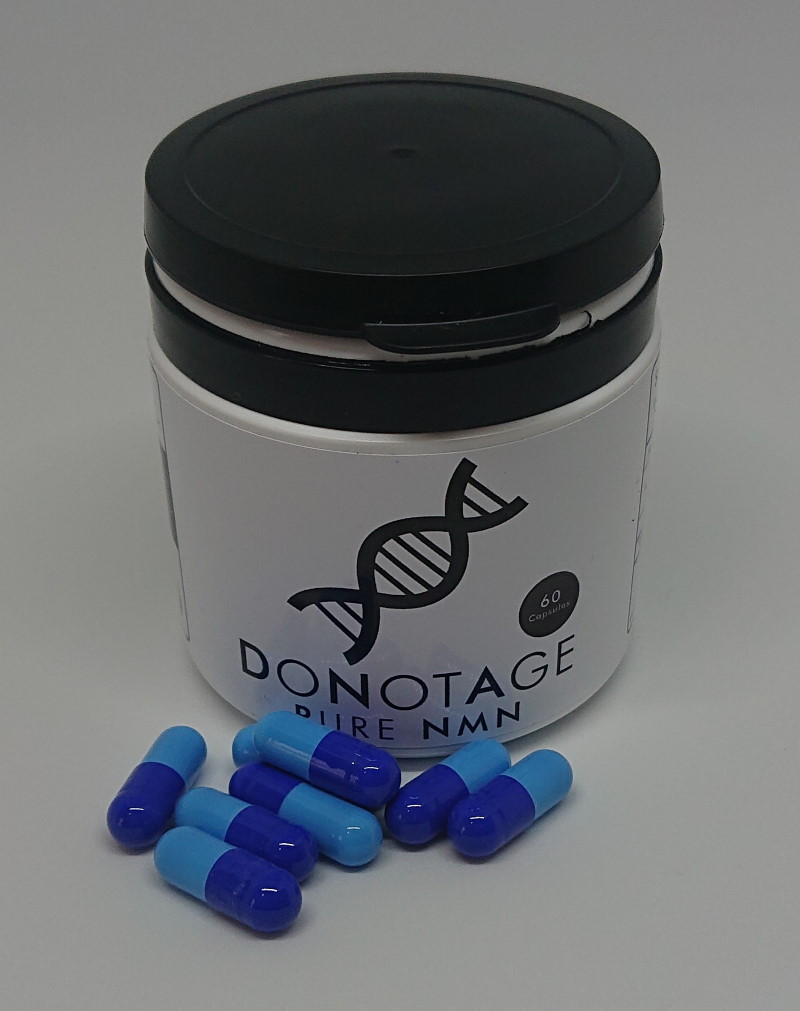
NMN supplied by DoNotAge (certificate of analysis states > 99.5% nicotinamide mononucleotide)
Note: the supplements are kept in the fridge for the duration of the trial. This is important as otherwise it can degrade into nicotinamide (NAM)7 – which has been shown inhibit sirtuins – the exact opposite of what we’re trying to achieve with NMN.
Testing will be a combination of blood analysis, home testing and self-assessment.
| Test | Frequency | Equipment |
|---|---|---|
| Blood analysis | Start and end | Medichecks* Well Man UltraVit Blood Test (no fasting) |
| Blood pressure | Weekly | Omron IntelliSense M6* Comfort Blood Pressure Monitor |
| Peak flow | Weekly | Mini-Wright* |
| Weight | Weekly | Omron BF508* Body Composition and Body Fat Monitor |
| Mood | Daily | Self-assessment, tracked using MoodScope (initial plan was Cara Care app but MoodScape is provides a quantitative score) |
What changes should I look out for at the end of my trial? Research in mice1 has reported a long list of beneficial effects on various physiological functions:
The big question still, and this will only be answered with a large-scale human trial, is whether these benefits transfer to humans. On this low budget, personal trial I won’t be able to check all of those functions, so I’m picking some that I can try to monitor the impact on myself.
I’m a regular runner, with every session logged in a spreadsheet - old-school I know! After a few years of improvement I know have a reasonably consistent pace for short and medium distances, so it will be very interesting to see if that changes over the trial. Though I’m not expecting the results that David Sinclair saw in his mice – they ran for so long the tracking computer hit a bug as it hadn’t been programmed to support mice running more than 3 kilometres!
One effect not on the list above is general energy levels – but that’s probably because you can’t ask a mouse how it is feeling. I tend to feel a bit tired most afternoons when working and sometimes sneak in a 5-10 minutes “power nap”. It will be really interesting to see if this urge to snooze goes away.
| Biomarker | Function | Method |
|---|---|---|
| Alanene transferase | Liver | Blood analysis |
| Bilirubin | Liver | Blood analysis |
| Blood pressure | Heart | Home test |
| Cholesterol ratio | Heart | Blood analysis |
| CRP - High sensitivity | Inflammation | Blood analysis |
| HbA1c | Diabetes | Blood analysis |
| eGFR | Kidney | Blood analysis |
| Mood | Mental energy | Self-assessment |
| Eye tiredness | Eye function | Self-assessment |
| Peak flow | Lung | Home test |
| Sleep quality | Sleep | Self-assessment |
| TSH | Thyroid | Blood analysis |
| Weight | Multiple | Home test |
Most biomarkers are being measured objectively so should reflect any genuine physical effects of taking NMN. The only exception is mood which is susceptible to the placebo effect – I can’t deny that I’m quite excited to be trialling it, so I’ll do my best to take that into account when judging my mood.
Although there have not been many human trials with NMN, given the number of people already taking it as a supplement I think if there was a serious risk of acute injury that this would have been noticed by now. But it’s worth looking a bit deeper into any possible health risks.
Generally speaking, in mice studies the animal models have suffered no adverse reactions or toxic effects. With anti-ageing treatments there is always the possibility of increasing the risk of cancer – as most improvements to cellular activity apply across the board, to good and bad cells alike. Although no increase in cancer incidence has been no observed in mice studies, one concern is that for certain types of cancer (pro-inflammatory senescent cell tumour growth) boosting NAD+ may help already established tumours to grow. This is a low risk which I am prepared to take for the much greater chance of an improvement to overall health, and therefore a reduced risk of all other types of cancer.
There has been a very basic human safety trial carried out by Keio University School of Medicine8. This small trial involved 10 healthy men aged between 40 and 60 years old orally taking small doses (100, 250, or 500 mg) at least one week apart. They concluded that it did not cause any significant deleterious effects.
Shin-ichiro Imai, at Washington University School of Medicine, is currently performing a more detailed placebo-controlled study11 with 30 people, 15 of which will be taking 250 mg of NMN per day for 8-10 weeks. I’ll post news of the results of that on the website when available.
As my initial trial is only for month, I would hope to catch and serious issues before any potential damage is done by reviewing the end-of-trial blood analysis.
Risk assessment done… let’s get on with the trial!
Remember, this is a N-of-1 trial so none of the results will be statistically significant – there could be other reasons to trigger any observed changes, including simple random variation. But hopefully if you’re thinking about taking NMN supplements, this will give you food for thought.
I undertook a Medichecks* Well Man UltraVit Blood Test before and after the trial, and selected (in advance) some key biomarkers that might respond to overall improvement in physiological function.
The table below shows the initial and final values for these measurements.
| Biomarker | Start | End | Units | Normal Range | Change |
|---|---|---|---|---|---|
| Alanene transferase | 27.9 | 19.1 | IU/L | < 50 |
|
| Bilirubin | 12.7 | 13.9 | umol/L | < 24 |
|
| Cholesterol ratio | 2.7 | 2.35 | N/A | < 4 | |
| CRP - High sensitivity | 0.6 | 1.34 | mg/L | < 5 |
|
| HbA1c | 38.7 | 36.9 | mmol/mol | 20 - 42 | |
| eGFR | 72.8 | 74.6 | ml/min/ 1.73m2 | > 60 | |
| TSH | 1.72 | 1.77 | mIU/L | 0.27 - 4.2 |
Most test results were unchanged, but I’ve highlighted any that have varied more than 10% in either direction.
Alanene transferase (ALT)
This is an enzyme which is mostly found in the liver and raised levels can suggest that the liver is damaged or diseased, for example, cirrhosis or fatty liver disease.
This drop of almost a third (from 27.9 to 19.1 IU/L) is particularly significant as that reading, for me, has been over 25 for the last 5 years of testing.
Note: this is sometimes also called “alanine aminotransferase” or “serum glutamic-pyruvic transaminase” (SGPT).
Cholesterol ratio
A great general indicator of heart health, and now considered more important that total cholesterol levels, given there is good and bad versions.
Only just exceeding the 10% change criteria (down to 2.35 from 2.7), it’s another significant change in my opinion as my reading has been consistently above 2.5 for over 10 years, so to drop suddenly seems like a good result. Looking at the cholesterol breakdown, the reduced ration is due to an increase in HDL.
CRP - High sensitivity
Now for the bad news. Background inflammation (or inflammaging) is a fundamental cause of many age-related diseases. So it’s disappointing that this has jumped up by over 100%! Unlike the other results above, that have always been reasonably consistent, I have previously had a couple of high readings. CRP-HS is sensitive to short-term infections, even the common cold, so it’s a shame I won’t be able to test for this again in a couple of weeks time to see if it subsides.
If NMN does raise C-Reactive Protein levels then that would be very worrying. I can’t find any research linking NMN with CRP, but see reference below for related supplements. A single dose study of NAM14 saw a small increase, but a (slightly larger, placebo controlled) trial of NR15 did not – so the jury is still out.
The plan was to take my blood pressure weekly, but I took it a few extra times near the beginning as it had risen a little and I wanted to be sure it wasn’t going to increase dramatically. Because the initial jump was in systolic pressure (which came down again after 2 weeks) I didn’t notice at the time a significant jump in my diastolic pressure the week later. It never went over 75, so nowhere near even prehypertension, and is slowly coming lowering - but worth noting. A month after the trial diastolic BP and pulse were still higher than at the start.

I used a Mini-Wright Weekly with an EU scale. According to the chart, for my age and height I should be hitting 615 litres/minute (l/min). Assuming I have good lungs from running, I was a bit disappointed to only achieve 570 pre-trial. This has jumped up 600-610, but as I’ve not done this test before, it is possible that the improvement was just me improving my technique. I continued monitoring this for a few weeks post-trial and average PEF came down from 600 to 590, so perhaps not just improved technique but a real impact on lung function.
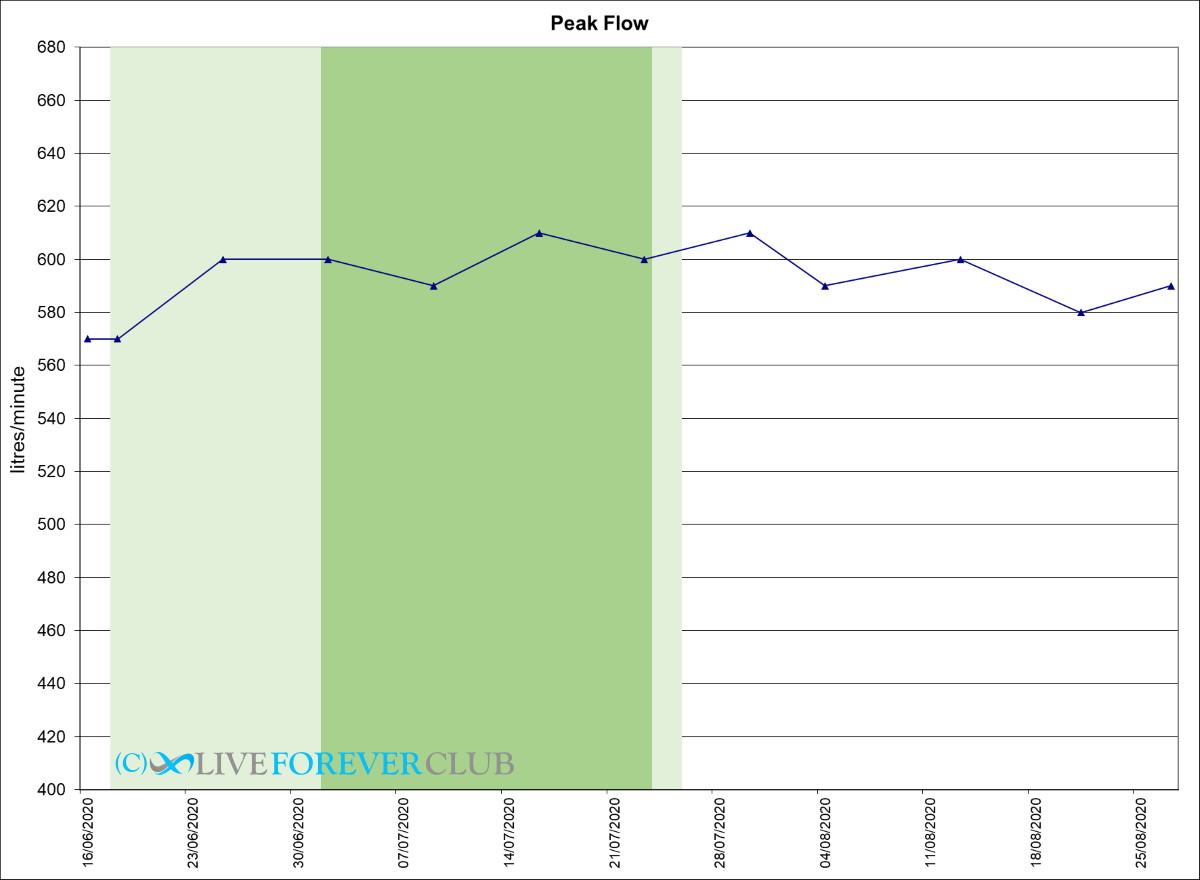
Again, this was checked weekly. I don’t know whether it is the Omron scales but fat percentage does fluctuate quite a bit so I’d say that looks normal and weight didn’t really change any more than usual either. However, with the post-trial run-off it appears that both total weight and fat percentage may have increased during and after the trial.
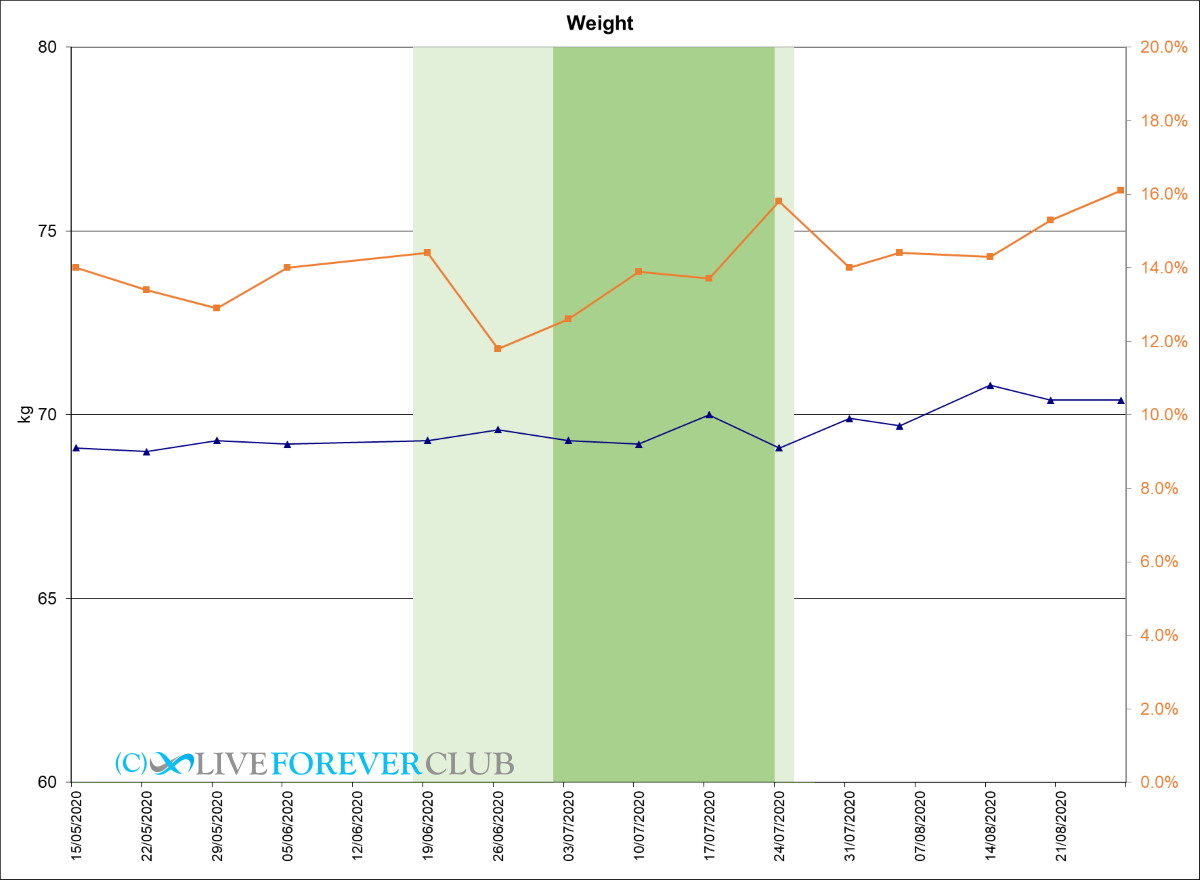
Another factor that I hadn’t monitored before the trial (lesson learnt, always good to baseline for a period of time before starting – not just a one off measurement on day 1) is my mood, which I’d say is flatline optimistic! I was just going to use the simple self-reporting on the Cara Care app but then found the MoodScope tool that is a bit more comprehensive and provides a quantitative score.
Quality of mood did seem to increase during the trial, and with dosage - 70% average while taking 0.5 g and 77% while taking 1 g/day. Again, this might have just been me adjusting to the test getting used to its questions, so another to monitor to see if it drops post-trial. Update: It does look like the average dropped back down to about 73% in the month after the trial.
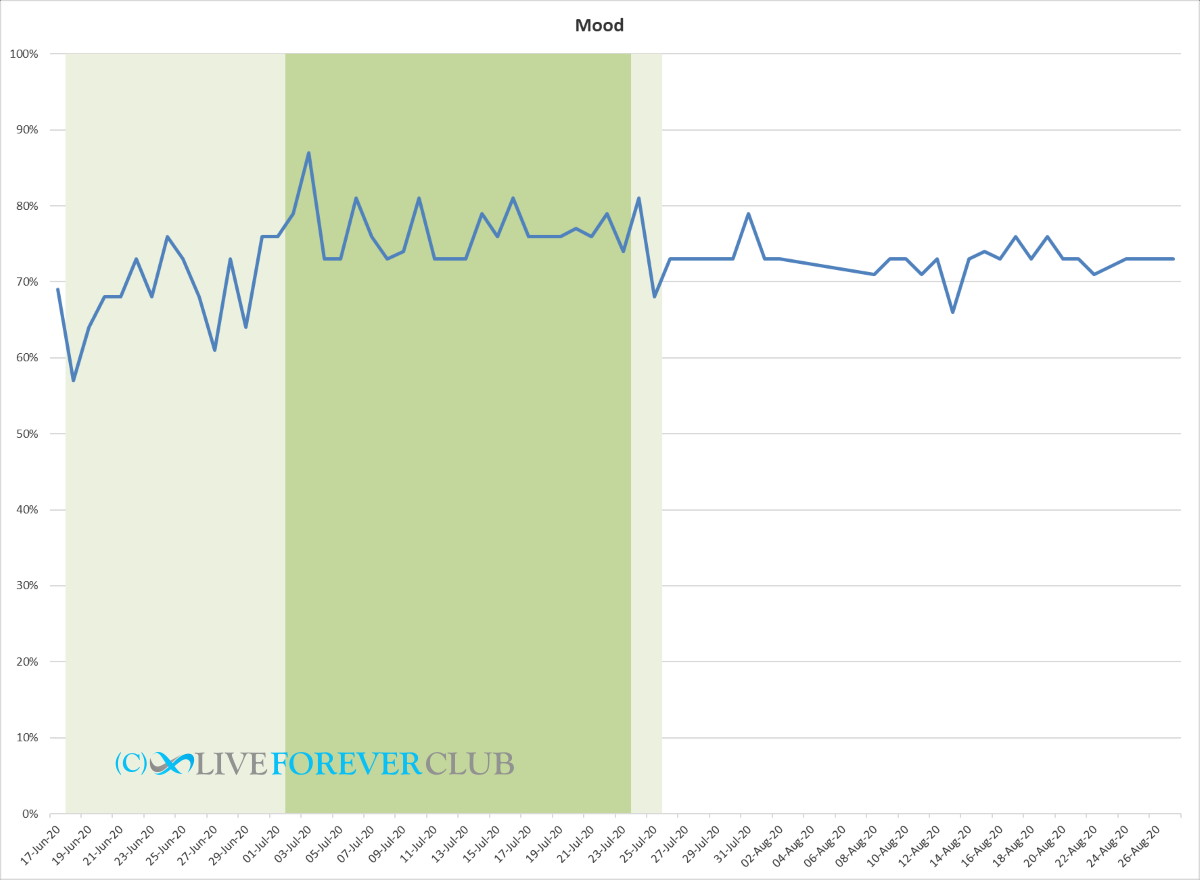
Although not subject, as every run is timed, it is possibly the most open to placebo or other effects. For example, possibly because I’ve been checking to see if my time has been improving, I’ve been more focussed on times and therefore beating them. I don’t usually go out to set a personal best (i.e. I don’t push to the limit every time) but on the last day of the NMN trial I did set out to go as fast as I can – and did manage to set a personal best for 3 miles.
Looking at the graph, I hadn’t noticed before that I had been slowly improving over the previous 3 months, so the faster times could just be a continuation of that. However, after the trial my pace did seem to drop back down to pre-trial speed – and I’ve definitely noticed that after my 8 mile runs I’m back to needing a good few minutes recovery and feeling tired for the rest of the day – both things that went away while taking NMN.
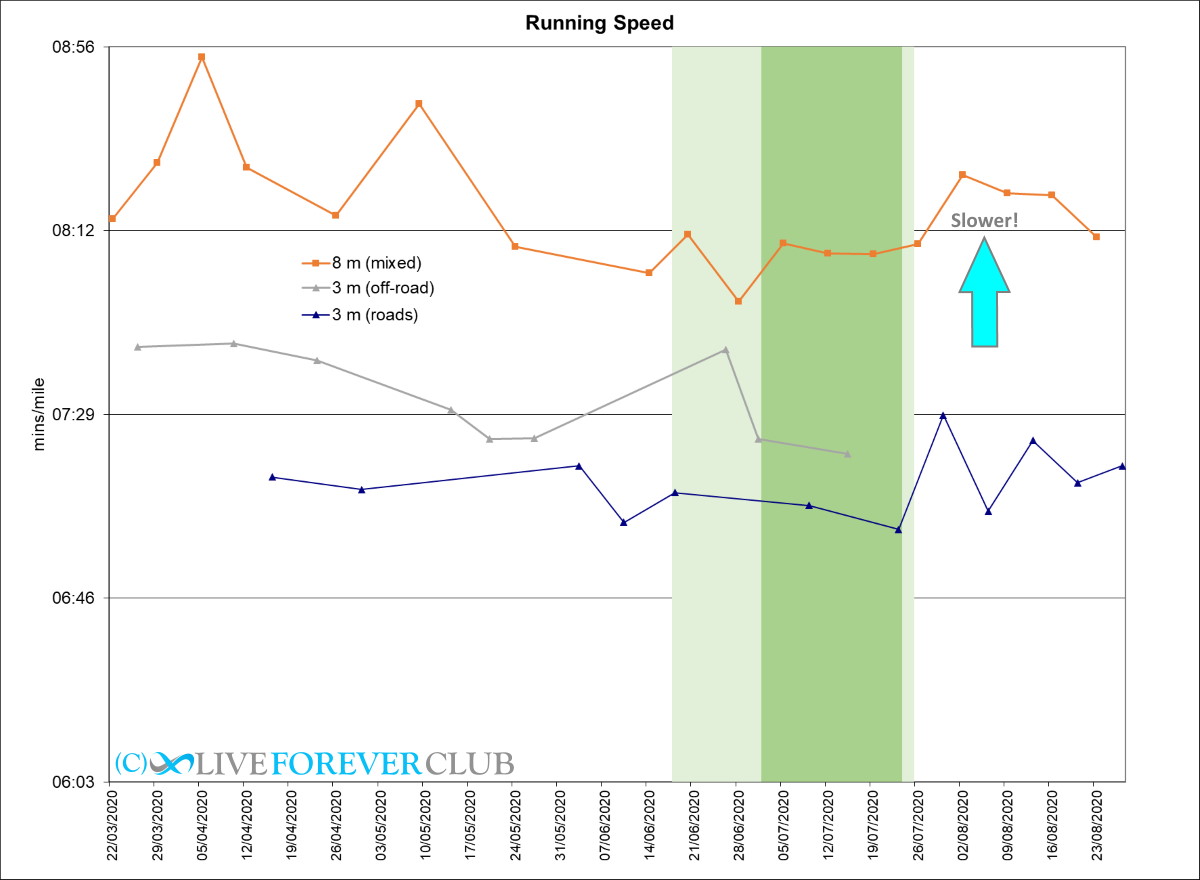
Although I have felt like my eyes have been less tired, for example, less frequently scrunching them up to “reset” them, I should have thought of a more quantitative test. And possibly, although not any better vision, perhaps low light isn’t worrying me as much – that’s a big factor as to whether I need to reach for the reading glasses or now.
So, no graph for this one, but general assessment of “feels better”.
Overall, I definitely felt like I had more energy almost immediately after starting to take NMN supplements. Of course, I may have just been excited to be doing the trial or suffering from the placebo effect.
Blood results seem the least prone to placebo effects and are definitely objective rather than subjective. The 2 positive changes stand out as they buck long-term trends after only a month of supplementation – that really does seem to be beyond statistical noise. However, the CRP (inflammation) reading is a worry, but I’m hoping it was an acute infection or something.
Looking at the non-blood results, there were possible improvements to fitness, lung function and mood – though I’ll continue to track these for a month post-trial to see if they drop again. I don’t know whether NMN (or its rejuvenating effects) builds up in the cells and therefore the washout period could be days, weeks or months. Expect a final update early September.
It does show that a serious approach to supplementation (of any kind) would require regular blood testing (monthly, or quarterly at least) and consultation with a doctor who could really understand the underlying mechanisms and advise and changes to your supplement stack.
The million dollar question
Will I continue to take NMN?
That depends. I’m certainly going to be interested to see if the effects wear off – do I go back to generally feeling tired? Does my running pace slow down? If they do, and cost was no object, and it was the only NAD+ related supplement available I think I would continue.
Basically, if I just wanted to do something NOW to make a difference – then yes, count me in.
TIP: I’m glad I decided to ramp up dose – although David Sinclair takes 1 gram per day, perhaps he worked up to that slowly. I definitely felt “whizzy” for the first half of the trial, even with doing 500 mg per day for the first 2 weeks, so wouldn’t have wanted to jump straight in to the 1,000 mg dose.
What’s Next?
There are other NAD+ precursors available, which I plan to run N-of-1 trials with too.
I learnt some lessons from this exercise about how to conduct a trial, even when only a single participant – do a month’s baselining beforehand, and need to have a longer duration (maybe 2-3 months) to really see if a pattern emerges in the statistics.
Watch this space.
UPDATE: I've not done a trial with NR too - NR Supplements Personal Case Study
I’ve left in the weekly updates I posted as the trial was in progress, to provide a more subjective report of how it felt as I went along.
I’ve updated all the graphs with 4-5 weeks of run-off data. Most do seem to show a rebound to pre-trial levels. And also on the more subject tests I do seem to be feeling tired again and have had a handful of short afternoon “power naps” (5 minutes typically) which I managed without while on NMN.
Quick update this week as all going well. I’ve had a couple of brief (minutes each) reminders of feeling tired and having tired eyes – was I really like that most of the time? It will be interesting to see whether I return to those feelings when I stop taking NMN. Also, blood pressure totally back down to normal, so may have been a blimp (it does vary month by month) or the body adjusting to its new metabolic rate.
This week I attained a personal best for my 3 mile (off-road) running routes and also an improved peak flow test. My pace has been slowly improving over the years, but it seems like a coincidence that I get a PBs for both short and long distances during the trial. Another to monitor post-trial to see if it drops back down again.
Otherwise, still pretty much the same. Still full of energy, and feels like I’m not so tired after a bit of weekend gardening. I have had a couple of micro-naps (sub-5 minutes) – but the difference being I’ve not had a background urge for one all day, just felt like a quick recovery shut-eye after a particularly intense bit of mental work. It will be very interesting to see if I go back to feeling tired after the end of the trial – I’ll be doing a supplemental report about a month afterwards.
Four to five days into the full dose, I did feel like I had slightly bulgy eyes and that I was whizzing around a bit too fast, but checked my blood pressure and that was looking OK. Days six to seven (today) have been better.
A similar report to last week – definitely feeling like I have more energy and eyes don’t feel tired anymore. I’ve just done a home blood pressure check and it’s the highest it has been for 4 months – it does vary quite a bit, but one to watch.
The strange running sweat incident hasn't repeated itself (but I only do 1 long run a week, so still monitoring) though I did do a personal best (PB) for 8 miles off-road. As always, could be a coincidence, but I’ve lots of running data for the months before the trial so will be interesting to see if the average increases for the duration.
If these improvements are statistically significant then they should really firm up over the next few weeks as I’m about to increase my daily dose to the full 1,000 mg (1 gram).
I’ve tried to determine whether it’s better to take it all in one go (like David Sinclair) does, or to spread it out. There’s not much information around (unsurprising given the lack for studies in humans) though one supplier recommends not splitting doses below 300 mg. The argument for and against seems to revolve around possibly needing a high enough level to overcome metabolism and to get it into the cells, versus using too much in one go might result in it being flushed away before it can be incorporated.
A review of research into the biology of NAD+ intermediates suggests that the NMN doesn’t last that long in the blood stream13, so I’m going to stick with my original plan of split dose. Though I’m now going to take the second dose late afternoon so that (i) it reduces the risk of sleep problems, and (ii) it might give a boost to my early evening exercise.
One week in, so too early to make any real assessment (especially with only one trial participant) but thought I’d report back on my subjective evaluation so far. Definitely too early to even look at first week home tests (blood pressure, peak flow, etc).
I’m currently on half dose (500 mg) so wouldn’t expect to feel any effects, though I have to say that from day 1 I think there’s been a slight increase in my energy levels. I’ve got used to a background yearning for a snooze – almost from the time I wake up I’d be happy to have 5 minutes with my eyes closed on the sofa, not that I often took one. But from day 1 of my NMN trial that urge seems to have receded. On the first day I put it down to the excitement of starting on the supplements, but a week on and I still feel the same. It’s like the feeling when, after thinking a cold has passed for a few days, it really does go away and you remember what a clear head really feels like. That’s the sensation I have now.
Another positive is my eyes. I don’t think I can see any better than before (that would be a very quick response) but I’m not feeling the need to scrunch them up so often or really concentrate to focus on something. One to watch (pun intended!).
Now for the downsides. I’ve noticed a few aches that I didn’t have before – almost like muscle bruises. It could be coincidence or somehow the cells are making themselves known, but will be interesting to see if that goes away. Also, on my weekend run I had a hot and sweaty period 3-4 miles in, as if I was running in a heatwave. It was hot, but not that hot. Again, it might be coincidence, and I’ll note if it happens again.
Overall, I’m happy with the way things are going, and am looking forward to increasing my dose next week to see if I notice any more changes.
1Long-Term Administration of Nicotinamide Mononucleotide Mitigates Age-Associated Physiological Decline in Mice - Cell Metabolism 2016
2Why NAD+ Declines With Age – LEAF
3Why NAD+ Declines during Aging: It’s Destroyed – Cell Metabolism 2016
4Age-Associated Changes In Oxidative Stress and NAD+ Metabolism In Human Tissue – PLOS ONE 2012
5In vivo NAD assay reveals the intracellular NAD contents and redox state in healthy human brain and their age dependences – PNAS 2015
6NMN Is Present in Various Types of Natural Food - Long-Term Administration of Nicotinamide Mononucleotide Mitigates Age-Associated Physiological Decline in Mice (Table 1) – Cell Metabolism 2016
7Why keeping NR & NMN supplements cold is crucial - David Sinclair on FoundMyFitness
8Effect of oral administration of nicotinamide mononucleotide on clinical parameters and nicotinamide metabolite levels in healthy Japanese men - Endocrine Journal 2020
9Telomere Dysfunction Induces Sirtuin Repression that Drives Telomere-Dependent Disease - Cell Metabolism 2019
10NAD+ in Aging: Role of Nicotinamide Riboside and Nicotinamide Mononucleotide - FoundMyFitness (YouTube)
11Effect of "Nicotinamide Mononucleotide" (NMN) on Cardiometabolic Function (NMN) - ClinicalTrials.gov
12NMN dosage recommendations (split above 300 mg) – New You Cell Renew
13NAD+ intermediates: The biology and therapeutic potential of NMN and NR - Yoshino, Baur, & Imai - Cell Metabolism 2018
14Nicotinamide Riboside Augments the Aged HumanSkeletal Muscle NAD+Metabolome and InducesTranscriptomic and Anti-inflammatory Signatures – Cell Reports 2019
15A nonrandomized study of single oral supplementation within the daily tolerable upper level of nicotinamide affects blood nicotinamide and NAD+ levels in healthy subjects - Translational Medicine of Aging 2020
Click on resource name for more details.
Club discount available - click here
On a mission is to extend healthy lifespan for as many people as possible
Age Reversal in Mammals – Has This Now Been Achieved?
Genflow Seeks Investors for Novel SIRT6 DNA Repair Anti-Ageing Therapy
What consumer tests are available to check your hallmarks of ageing and how they're impacting your body?
A good jump in NAD levels and grip strength during this one month trial, but not everything improved
What is the impact on physical biomarkers from taking spermidine supplements?
2 month trial of nicotinamide riboside NAD booster Tru Niagen